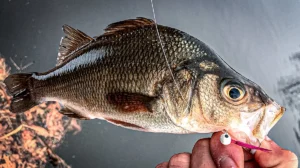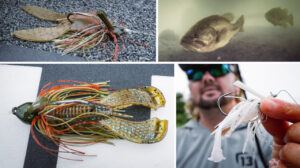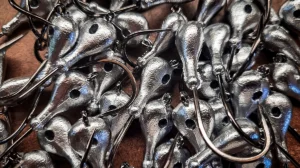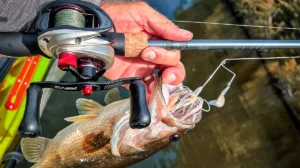Spider rigging for crappie is the fastest growing tactic in the crappie fishing sport, and for good reason. With an increasing number of crappie fishermen realizing that spring is not the only, nor even the best time to catch crappie, spider rigging has revolutionized what was once a “cane pole and bobber” sport.
While getting started can seem daunting and appear to be the beginning of an unavoidable mess, being able to effectively push 4 to 10 poles does not take super-human ability or a PhD in quantum physics. It simply involves baits in the water and guiding your vessel in the direction and speed wanted to cover an area.
What some see as foreign or unsporting others have perfected and passed down for generations. Some states strictly prohibit the use of multiple rods so be sure to check your local regulations before starting.
Creel limits apply regardless of how many rods are used, and on the vast, coverless, muddy water reservoirs in the south where nomadic crappie scatter throughout the water column like stars in the sky, catching a mess of fish is nearly impossible during certain times of the year without a spider-rig approach.
What is spider rigging
Spider rigging, slow trolling, pushing, dragging, or whatever you might call it, consists of putting multiple poles, commonly 8, in rod racks and fanning them out 180 degrees on the bow of the boat while pushing baits and keeping the main lines near vertical. A precisely controlled drift, utilizing chains or wind socks drug from the back of the boat, or running an electric trolling motor at extremely low speeds is how anglers maintain the most important element of this tactic, boat control. In most situations, 0.3 mph is the ideal speed, hence the term slow-trolling. The most common terminal tackle is a double-hook minnow rig, with the dominant bait being live minnows.
Why it works
When crappie are far away from the visible structure and shallow banks they frequent during the spawn, the most effective method to entice these tasty panfish is slowly pushing multiple baits across a wide swath through likely areas. Prespawn crappie stage just out from spawning areas. Post-spawn crappie become nomadic and lethargic and cruise back to deeper waters. Fall and winter crappie school up and stalk baitfish in open water and submerged cover. The most effective way to consistently catch all of these fish is spider rigging.
Boat Control
Precisely controlling your boat is the most important aspect of spider-rigging, and can mean the difference between a successful day on the water and a disaster. Consider the control and precision you use when holding a jig pole or casting rod, now imagine holding that same rod, but frantically swinging it all over the place like you were swatting at a bee. The boat acts as your hands, and maintaining speed, direction, and overall presentation is dictated by the control of the vessel.
- Why it’s so important – Just like all other tactics, figuring out how the crappie react to a particular presentation is key to catching fish. There are times when sitting still and putting live bait in front of a fish is the only way to trigger a strike, as well as times when the difference between 0.3 mph and 0.5 mph can mean filling the boat or getting blanked. When pushing baits through cover, losing control of the boat can quickly cause snapped lines and broken poles, especially in heavy wind.
- Trolling motor – While most anglers try to spider rig with the wind, there is a time and place for pushing into it, namely on calm days and when fishing big brush piles or mats. Regardless if your motor is cable or electric drive, variable speed is a must, because the perfect speed is rarely found on one of the settings of a 5-speed motor.
- Wind Socks – The most common method of controlling boat speed and direction is by employing wind socks. Wind socks are large cones made of vinyl or similar material that have a float sewed into one side of the large opening on the cone, and weights sowed into the opposite side. This causes them to deploy when they’re thrown out behind the boat, catching water and creating a strong drag. Wind socks are not designed to slow boats down to the crawling speeds common in spider rigging, so the ratings printed on the package do not apply. The rule of thumb with wind socks is to get the biggest size possible, and get two, one for either side of the back of the boat. An 18 foot boat requires two, 40 to 50-inch socks to slow down to 0.4 mph in moderate wind.
- Dragging chains – In shallow water lakes with heavy cover, or when fishing in very heavy winds, wind socks are not feasible. They will hang on cover, and can only slow you down so much in high wind, this is when serious anglers break out the chains. A 4-foot length of heavy log chain tied to a rope and drug from behind the boat will hinder boat speed more than socks, however a lull in the wind will cause you to stop and have to adjust the chain. By letting out more rope, more of the chain will lay on the bottom creating more drag, while pulling in rope and letting less of it touch the bottom will increase speed.
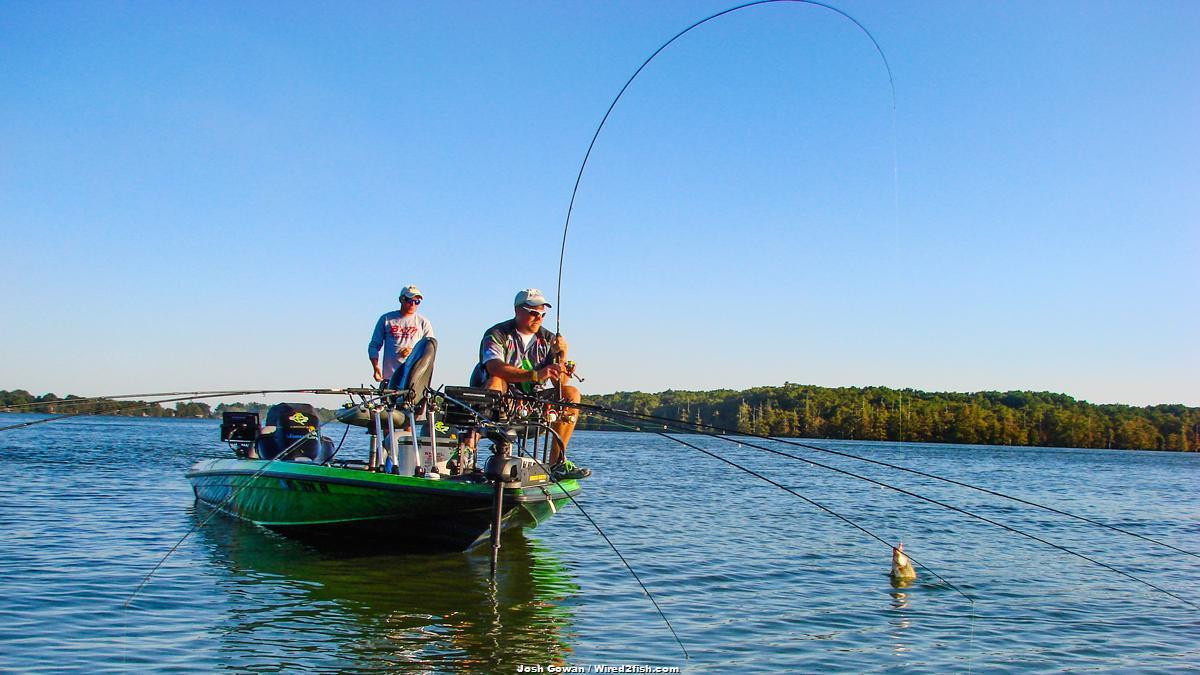
When and where
By adjusting speed, depth and baits, spider rigging can catch crappie year round.
- Late fall to early winter is the best time to be on the water if stocking the freezer is the most important factor. Crappie are actively feeding and are often found in large schools, or at least in moderately close proximity to one another. On lakes where crappie and baitfish are cover-oriented, they will be congregated in the mid levels of the water column most of the time, stalking prey. On large reservoirs where cover is minimal, crappie will school up and can easily be spotted with fish finders. Crappie are feeding, so location depends on baitfish. Starting deep and working up channel ledges is a safe bet, as well as deep water flats.
Pro tip: When pushing baits through stumps, above brush, or around artificial cover this time of year, park your baits as close to the cover as possible and sit still. Cover-oriented crappie will often “nose-up” to cover and slowly stalk their prey, and antagonizing them into biting is best done with live minnows or stinger style plastics. When schooling fish won’t bite, start down-sizing and changing colors. There is almost always something that will trigger a bite, even when fish have an extreme case of lockjaw.
- Late winter to early spring is probably the most exciting time to spider-rig, with crappie at the peak of their growth cycle before the spawn, often moving into shallower waters, and extremely aggressive. This is when 14-foot rods get buried “8 eyes deep” and the fisherman has a split-second to enact a hard hook-set or sit wondering just how big the one that got away was. Crappie are on their way to the spawning areas, and usually in the general vicinity of where they spawned the year before. Working ledges from flats up to cover is a good place to start, as well as pushing baits through and around shallow water cover.
Pro tip: Once you find crappie this time of year, getting them to bite is not the most difficult part, it’s landing the fish. Shallow water, prespawn crappie are as aggressive as they come, and will smash baits and run, giving anglers a split-second before your line is near horizontal and the hook is in the corner of the fish’s mouth, often resulting in lost fish. Going down to four poles and placing your hands on the rods will allow you to feel the bite, and get quick, top-of-the””mouth hook-sets. A long, light net is also recommended to quickly get under fish hung on long poles from short lines.
- Mid to late spring crappie that are spawning on submerged cover like stumps or horizontal logs can be effectively fished by spider rigging. This time of year requires lightning-fast reflexes as most “spawning” crappie are males that are guarding the nest. They will smash a bait and spit it out before an angler can react. Slow-trolling around spawning areas during the spawn can be effective early on, as big females stage just outside of cover while males prepare for their arrival. The most effective areas to spider rig during the spawn are submerged cover and rock ledges where males are preparing for or protecting the eggs.
Pro tip: Male crappie don’t actively feed during the spawn, they will often inhale the bait, chomp it and spit it out, assuming it is after their eggs. Quick hooksets are key, and again going down to fewer rods will help. On lakes where crappie spawn on standing timber or exposed brush, a “jig and troll” method can be effective. Putting a few poles out to one side while vertical jigging cover will give you the chance to catch aggressive males and staged females at the same time.
- Late spring to early summer post spawn crappie are notoriously finicky and nomadic, which is why pushing live bait at a snail’s pace is sometimes the only way to catch them. The difficulty with this time of year is reluctant, light bites that often go unnoticed by inexperienced spider-riggers. Crappie are leaving the spawning area and can be found making their way back to open water, often scattered but occasionally in loose schools on channel ledges and across flats.
Pro tip: Crappie are beginning to feed actively but are still lethargic from the spawn. Live bait is the best bet this time of year, but artificial bait can be effective if scent is added. Detecting bites is difficult because of the inactivity of the fish, so live bait or scent is necessary to ensure the crappie holds on to the bait long enough to notice the bite and set the hook. This is when hi-vis line really is important, as many bites will just show up as slight line movement.
- Mid summer to early fall is the toughest time of the year for traditional slow-trolling spider-riggers, but by using heavier weights and increasing speed, triggering reaction bites from lethargic crappie can be very effective. This variation of multi-pole fishing known as power trolling, does however require stiffer, tougher poles than those normally used for slow-trolling, as well as water mostly void of cover. Flats are the primary area this time of the year, as well as ledges near flats.
Pro tip: If you’re slow trolling and not getting bit, play with your speed and depths. Crank the trolling motor up and make a quick swing to the left, let off the trolling motor and allow the line to fall back to vertical, then swing back to the right and do the same. Catching a crappie at different points in this swing will indicate what presentation is best.

Bait selection
While live minnows will always dominate bait selection for spider rigging, there is no end to the combinations of baits that will work for crappie. One of the best parts of running multiple poles is being able to try different baits until you figure out what works best that particular day.
- Live bait Minnows are the standard when it comes to slow trolling. No. 2 Aberdeen hooks ran through the lips of minnows will trigger bites the majority of the time when slowly pushed past crappie.
- Tipping minnows – Many anglers tip plastics with minnows. Adding color to the action of live bait will sometimes increase your catch and trigger more aggressive strikes. The most common method runs a bare hook through a tube jig and then hooking a minnow through the lips. The skirt of the jig will sit on top of the minnow and add color as well as a bigger profile.
- Pushing jigs – Jig heads with plastics can be effective, especially when pushing a little faster than traditional slow-trolling speeds. Solid bodied plastics in curly or paddle tails are the most popular choice, as the tail emulates live bait.
Spider-rigging can seem daunting at first, but with a little research and a bit of practice, you can quickly stock the freezer with crappie the whole year.




